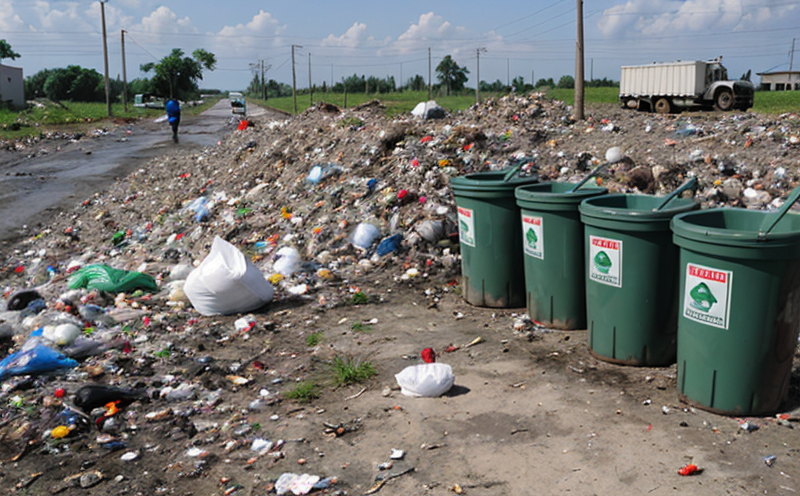ASTM D5232 Extraction of Hazardous Constituents in Solid Waste Test
The ASTM D5232 standard test method is a critical tool used by environmental laboratories and researchers to extract hazardous constituents from solid waste samples. This extraction process aims to identify potentially harmful substances that may leach into the environment, posing risks to human health and ecological systems.
ASTM D5232 specifies the procedure for extracting hazardous constituents using hot water or a suitable solvent from solid waste materials under controlled conditions. The extracted solution is analyzed to determine the concentration of specified chemicals, metals, and other potentially harmful substances. This method helps environmental professionals assess the potential risks associated with landfill leachate, incinerator ash, construction and demolition debris, and other types of solid waste.
The ASTM D5232 test ensures that hazardous materials are accurately identified and quantified in compliance with international standards such as ISO 15806:2017. This compliance is essential for regulatory purposes, ensuring that waste management practices meet stringent environmental protection requirements set by authorities like the EPA (US Environmental Protection Agency).
Before performing this test, it's crucial to ensure that all necessary equipment is properly calibrated and maintained according to manufacturer guidelines. The testing process involves several steps, including sample preparation, extraction, filtration, and analysis of the eluate using appropriate analytical techniques such as ICP-MS (Inductively Coupled Plasma Mass Spectrometry) or HPLC (High-Performance Liquid Chromatography).
Proper sample preparation is critical to ensure accurate results. Samples should be homogenized if necessary, and any contaminants must be removed before extraction. The extraction process typically involves adding a solvent like hot water to the solid waste sample at specified temperatures and durations, followed by filtration of the resultant solution.
After extraction, the eluate undergoes further analysis using methods outlined in ASTM D5232. Analysis focuses on identifying specific hazardous constituents, including metals (e.g., lead, cadmium), organic compounds (e.g., polychlorinated biphenyls or PCBs), and other potentially harmful substances.
Once the extraction process is complete, the extracted solution can be analyzed using various analytical techniques to determine the concentration of these hazardous constituents. The results provide valuable information for waste management professionals who need to assess potential risks associated with different types of solid waste materials.
The ASTM D5232 test is widely recognized as a reliable and robust method for extracting hazardous constituents from solid waste samples. Its accuracy and precision make it an essential tool in environmental testing laboratories around the world.
- Comprehensive extraction procedure
- Identification of various hazardous substances
- Accurate quantification of extracted materials
- Regulatory compliance with international standards
- Precision and reliability
- Cost-effective analysis method
- Efficient sample preparation process
The ASTM D5232 test plays a vital role in ensuring that solid waste management practices comply with environmental protection regulations. By accurately identifying hazardous constituents, this test helps prevent contamination of soil and water resources, protecting both human health and the environment.
Eurolab Advantages
At Eurolab, we pride ourselves on providing top-tier laboratory services that meet or exceed industry standards. Our state-of-the-art facilities and experienced team of scientists ensure accurate and reliable results for your solid waste testing needs.
- Accreditation: Eurolab is fully accredited by A2LA (American Association for Laboratory Accreditation) and ISO/IEC 17025:2017, ensuring our laboratory meets the highest quality standards.
- Experienced Staff: Our team comprises highly qualified professionals with extensive experience in environmental testing and research.
- Advanced Equipment: We use cutting-edge technology to perform ASTM D5232 tests accurately and efficiently. Our equipment is regularly calibrated and maintained by certified technicians.
- Dedicated Support: Our customer service team is available to answer any questions you may have about our services or the testing process.
- Compliance: We stay current with all relevant regulations, ensuring that your tests meet all necessary standards and requirements.
- Quality Assurance: Every test undergoes strict quality control measures to ensure accuracy and consistency in results.
Choose Eurolab for your ASTM D5232 solid waste testing needs. Our commitment to excellence, combined with our advanced technology and experienced staff, guarantees accurate and reliable results every time.
Environmental and Sustainability Contributions
The ASTM D5232 extraction test contributes significantly to environmental protection by identifying hazardous constituents in solid waste materials. This information allows for better management of waste, reducing the risk of contamination that could harm ecosystems and public health.
By accurately extracting and analyzing these potentially harmful substances, stakeholders can make informed decisions about proper disposal methods or recycling initiatives. The test results also enable compliance with stringent environmental regulations, fostering sustainable practices in various industries.
The data generated from ASTM D5232 testing helps minimize the impact of solid waste on soil and water resources. Through this process, we contribute to creating a more sustainable future by ensuring that hazardous materials do not enter the environment unchecked.
Moreover, Eurolab's commitment to excellence in environmental testing supports broader sustainability goals. By providing reliable data through ASTM D5232 tests, we empower decision-makers to implement effective waste management strategies that protect both people and the planet.





